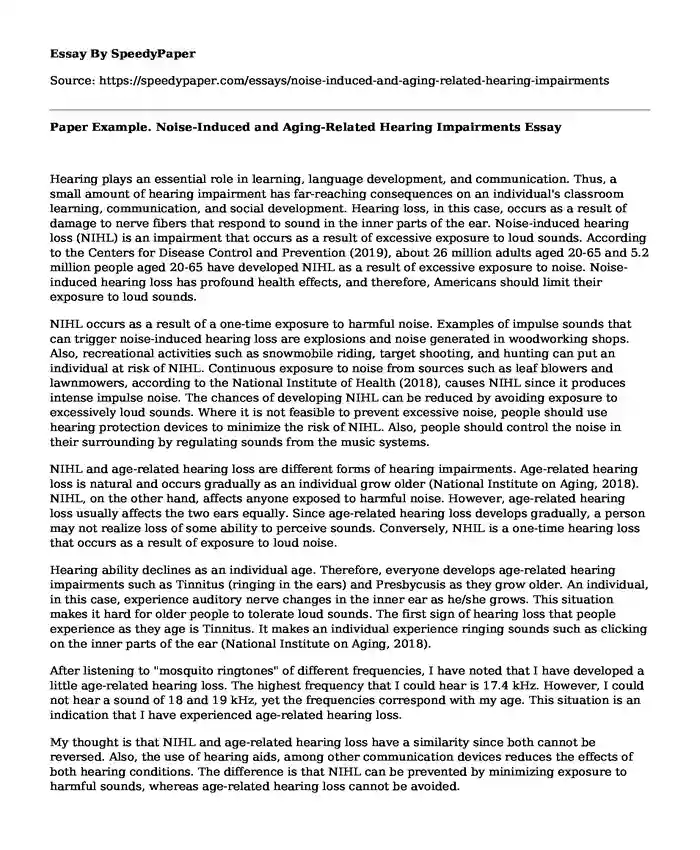
| Type of paper: | Essay |
| Categories: | Communication Medicine Community health |
| Pages: | 3 |
| Wordcount: | 647 words |
Hearing plays an essential role in learning, language development, and communication. Thus, a small amount of hearing impairment has far-reaching consequences on an individual's classroom learning, communication, and social development. Hearing loss, in this case, occurs as a result of damage to nerve fibers that respond to sound in the inner parts of the ear. Noise-induced hearing loss (NIHL) is an impairment that occurs as a result of excessive exposure to loud sounds. According to the Centers for Disease Control and Prevention (2019), about 26 million adults aged 20-65 and 5.2 million people aged 20-65 have developed NIHL as a result of excessive exposure to noise. Noise-induced hearing loss has profound health effects, and therefore, Americans should limit their exposure to loud sounds.
NIHL occurs as a result of a one-time exposure to harmful noise. Examples of impulse sounds that can trigger noise-induced hearing loss are explosions and noise generated in woodworking shops. Also, recreational activities such as snowmobile riding, target shooting, and hunting can put an individual at risk of NIHL. Continuous exposure to noise from sources such as leaf blowers and lawnmowers, according to the National Institute of Health (2018), causes NIHL since it produces intense impulse noise. The chances of developing NIHL can be reduced by avoiding exposure to excessively loud sounds. Where it is not feasible to prevent excessive noise, people should use hearing protection devices to minimize the risk of NIHL. Also, people should control the noise in their surrounding by regulating sounds from the music systems.
NIHL and age-related hearing loss are different forms of hearing impairments. Age-related hearing loss is natural and occurs gradually as an individual grow older (National Institute on Aging, 2018). NIHL, on the other hand, affects anyone exposed to harmful noise. However, age-related hearing loss usually affects the two ears equally. Since age-related hearing loss develops gradually, a person may not realize loss of some ability to perceive sounds. Conversely, NHIL is a one-time hearing loss that occurs as a result of exposure to loud noise.
Hearing ability declines as an individual age. Therefore, everyone develops age-related hearing impairments such as Tinnitus (ringing in the ears) and Presbycusis as they grow older. An individual, in this case, experience auditory nerve changes in the inner ear as he/she grows. This situation makes it hard for older people to tolerate loud sounds. The first sign of hearing loss that people experience as they age is Tinnitus. It makes an individual experience ringing sounds such as clicking on the inner parts of the ear (National Institute on Aging, 2018).
After listening to "mosquito ringtones" of different frequencies, I have noted that I have developed a little age-related hearing loss. The highest frequency that I could hear is 17.4 kHz. However, I could not hear a sound of 18 and 19 kHz, yet the frequencies correspond with my age. This situation is an indication that I have experienced age-related hearing loss.
My thought is that NIHL and age-related hearing loss have a similarity since both cannot be reversed. Also, the use of hearing aids, among other communication devices reduces the effects of both hearing conditions. The difference is that NIHL can be prevented by minimizing exposure to harmful sounds, whereas age-related hearing loss cannot be avoided.
Conclusively, auditory perception plays an essential role in communication and speech development. Mild to moderate hearing loss has profound consequences on an individual's comprehension and the ability to learn. Therefore, people should avoid exposure to harmful sounds since it increases the risk of noise-related hearing loss.
References
Centers for Disease Control and Prevention. (2019, August 19). Preventing Noise-Induced Hearing Loss. Retrieved September 18, 2019, from https://www.cdc.gov/ncbddd/hearingloss/noise.html/url/
National Institute of Health. (2018, September 7). Age-Related Hearing Loss. Retrieved September 18, 2019, from https://www.nidcd.nih.gov/health/age-related-hearing-loss/url/
National Institute on Aging. (2018). Hearing Loss: A Common Problem for Older Adults. Retrieved September 18, 2019, from https://www.nia.nih.gov/health/hearing-loss-common-problem-older-adults/url/
Cite this page
Paper Example. Noise-Induced and Aging-Related Hearing Impairments. (2023, Feb 09). Retrieved from https://speedypaper.com/essays/noise-induced-and-aging-related-hearing-impairments
Request Removal
If you are the original author of this essay and no longer wish to have it published on the SpeedyPaper website, please click below to request its removal:
- The Rise of Totalitarianism after World War 2. Free Essay.
- Explication Essay Example on the Poem Naming of Parts
- Psychology Essay Sample on Behavioral Problems
- Essay Sample on Developing of the Quick App Marketing App
- Free Essay Example: Personnel Budgeting, Planning and Productivity
- Helping Older People. Paper Example
- Essay Sample on Antioxidants Role in Disease
Popular categories




